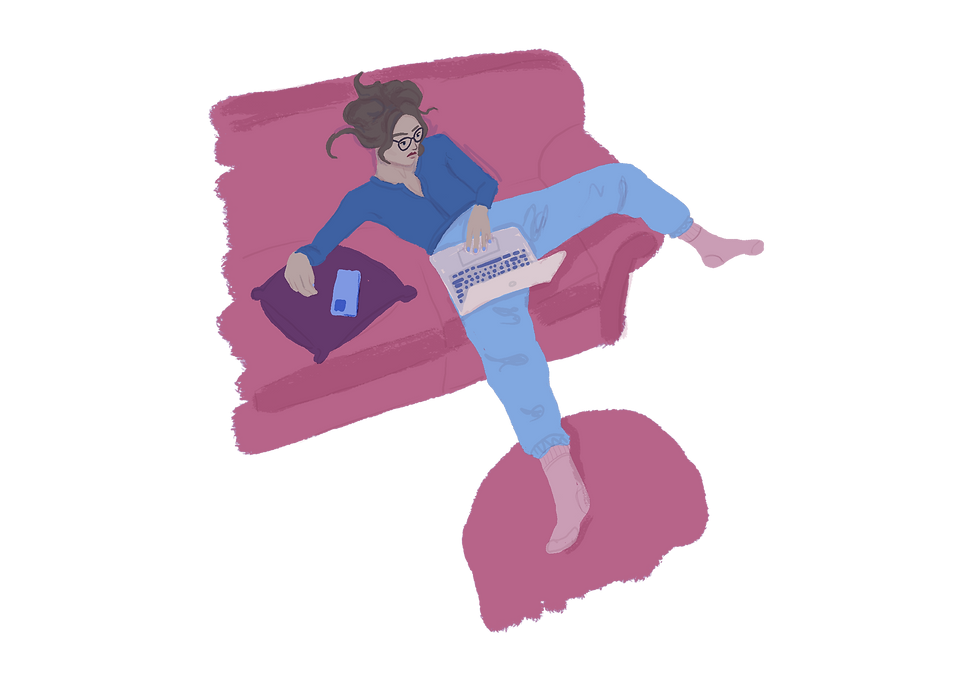How to Build a Capsule Brand (and stop Design decision fatigue in its tracks)
- Sophie Haren

- Jun 16
- 4 min read
Updated: Jun 17
Let’s talk about something that’s low effort, high reward, and just might save your brand sanity: a capsule brand.
This is for you if:
You already have a brand (even a half-baked one)
You’re tired of second-guessing every Canva design
You’re feeling “meh” after design sessions and you’re not sure why
Why You’re Burnt Out Every Time You Open Canva
Every time you sit down to “make something cute,” you’re making hundreds of tiny design decisions. Color, font size, line spacing, alignment, texture, border, shadow, icon style—and that’s before you even get to the content. That kind of cognitive load is design fatigue 101.
And you know what happens then:
You burn out halfway through
You hate what you made
You swear off content creation for a week
Here’s the fix: make 16 design decisions up front—your capsule brand—and reuse them for the next 90 days. This will save you thousands of micro-decisions. I’m not exaggerating.
What’s a Capsule Brand?
Think capsule wardrobe, but for your visuals.
You pick 16 visual elements (like fonts, colors, corner radius, textures, etc.) and commit to using only those for 90 days. Not forever. Just long enough to:
Build consistency
Reduce choice overload
Practice executing a vibe
It’s not a rebrand. It’s a focus tool. You’re working within creative constraints so you can actually create.
Why 90 Days?
Two reasons:
Design skills come from repetition. If you’re not a trained designer, you need reps. This lets you “wear” your brand for a while and figure out what works (and what doesn’t) before you commit long term.
Brands evolve. Your business changes. The internet changes. Design trends shift. A capsule brand gives you a structured way to adapt without totally derailing your look every time something new drops.
Eventually, you won’t need this. But until you’ve really built up design confidence (usually 12–18 months of intentional practice), this 90-day rhythm gives you permission to change slowly, not reactively.
What Goes Into Your Capsule Brand
Here’s the full lineup of the 16 elements you’ll define. You can grab the free Capsule Brand Decision Guide I made [insert link] if you want help mapping this out.
1–4: Color Palette
Lightest color (your white or background tone)
Darkest color (your black or main text color)
Two others that feel natural to you
Pro tip: if you’re unsure, screenshot the colors you use most often, grayscale them in Canva, and look at their value (lightness/darkness). You want contrast. Not everything should be mid-toned beige.
5: Background Texture
This one sneaks under the radar. Are your backgrounds flat? Do you use gradients? Subtle textures? A crumpled sheet photo? (That’s what I use—because WorkShy is about being cozy and lazy.)
Pick one, and stick with it. This tiny choice keeps your templates from looking like a design mood swing.
6–7: Fonts
Title font: This is your personality font. It can be fun, weird, expressive.
Everything-else font: Boring on purpose. Clear, legible, versatile. Pick one with multiple weights (regular, bold, italic, etc.) so you can actually format text without breaking the vibe.
8: Corner Radius
Decide if your stuff has sharp corners, soft corners, or full-on pill shapes. This controls buttons, image frames, boxes—so many things. Choose once, apply everywhere.
9: Line Style
Do you want:
Thin lines?
Thick lines?
Dashed lines?
Scribbly, hand-drawn ones?
Choose one. Consistency makes you look intentional, even when you’re winging it.
10: Drop Shadow
Sometimes you need a shadow—especially to make text readable. Choose a style and opacity level that feels right and stick with it. Shadow or no shadow—just commit.
11: Image/Video Filter
If you’re editing visuals or videos, define your favorite filter or LUT (look-up table). Apply it consistently so your stuff has a “feel.” Even TikTok filters count here. Put it in your brand doc.
12–16: Pick Your Own
These are the flexible five.
Some examples of what you could add, depending on your branding:
A pattern you use
An illustration or icon style
Your favorite “extra” color
A specific element you love (like paper tears, scribbles, photo corners)
An extra font (if you must)
Just make sure these are things you actually use often. And be specific—don’t just write “icons,” write “hand-drawn scribbly icons.”
Make It Easy to Use
Don’t just think about your capsule brand. Build it.
In Canva or your design tool of choice, drop all these elements onto one page. Use it like a living, breathing brand book. Copy and paste from it. Reuse. Tweak. Test.
Start every new Canva project by duplicating your capsule brand doc. Don’t start from scratch again. That’s how people end up with three different fonts and eight shades of pink in the same Instagram carousel.
Final Thought
Branding doesn’t have to feel like performance art. A capsule brand keeps things simple, clean, and consistent—even if you’re figuring it out as you go.
You're allowed to change things, but do it deliberately, not on a whim. Give your brand time to breathe before you overhaul it again. You’ll learn faster, look more polished, and actually get your content done.
If you want to try it, grab the [free Capsule Brand Decision Guide here] and tag me on Instagram when you finish yours. I wanna see.









Comments